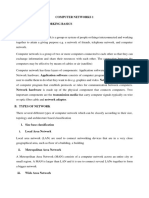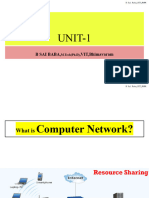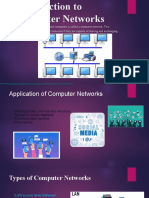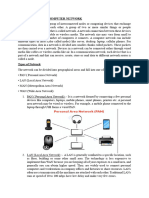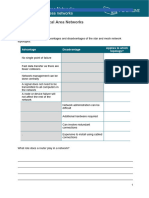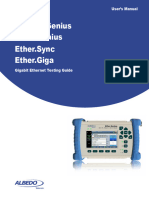Computer Networks
(UNIT 3)
Network:
A computer network is a collection of two or more computers linked together for the purpose of sharing
information and resources.
Need for networking:
• Resource sharing - files and peripherals
o Sharing of files and software
o Sharing Peripherals
o Sharing storage
• Improving communication
• Access to remote database
Requirements of a Network:
Every network includes:
o At least two computers - Server or Client workstation.
o Network Interface Cards (NIC)
o A connection medium, usually a wire or cable, although wireless communication between networked
computers and peripherals is also possible.
o Network Operating system software, such as Microsoft Windows NT or 2000, Novell NetWare, Unix
and Linux.
Internet: The Internet (or internet) is the global system of interconnected computer networks that uses
the Internet protocol suite (TCP/IP) to communicate between networks and devices.
Interspace: It is a client/server software program that allows multiple users to communicate online with real
time audio, video and text chat in dynamic 3D environments. It provides the most advanced form of
communication technology available today. It is a vision of what internet will become tomorrow.
Network Topologies:
Network topology is the arrangement of the elements of a communication network. Network topology can be used
to define or describe the arrangement of various types of telecommunication networks.
Network topologies are categorized into the following basic types:
o Bus
o Star
o Tree
o Bus Topology:
Bus topology is also known as Linear Topology. In this type of topology, each node attaches directly
to a common cable which acts as the backbone and therefore functions as a shared communication
medium onto which various nodes are attached. A device wanting to communicate with another
device on the network sends a broadcast message in both
directions onto the wire that all other devices see, but only the
intended recipient actually accepts and processes the
message.
Advantages of Bus Topology
i) Since there is a single common data path
connecting all the nodes, the bus topology uses a
very short cable length which considerably reduces the installation cost.
ii) The linear architecture is very simple and reliable.
iii) Additional nodes can be easily connected to the existing bus network at any point along
the length of the transmission medium.
Disadvantages of Bus topology
i) Fault detection and isolation is difficult. This is because control of the network is not centralized
in any particular node. If a node is faulty on the bus, detection of fault may have to be
performed at many points on the network. The faulty node has then to be rectified at that
connection point.
ii) If the central bus length becomes too long, then repeaters might have to be used to amplify
the signal. The use of repeaters makes reconfiguration necessary.
iii) Since each node is directly connected to the central bus, so there has to be some way of
deciding who can use the network at any given time.
• Ring Topology:
A ring topology is a network configuration where device
connections create a circular data path. Each networked device
is connected to two others, like points on a circle. Together,
devices in a ring topology are referred to as a ring network.
Advantages of a ring topology: -
• All data flows in one direction, reducing the chance
of packet collisions.
• A network server is not needed to control network
connectivity between each workstation.
• Data can transfer between workstations at high
speeds.
• Additional workstations can be added without
impacting performance of the network.
Disadvantages of a ring topology: -
• All data being transferred over the network must pass
through each workstation on the network, which can
make it slower than a star topology.
• The entire network will be impacted if one workstation
shuts down.
• The hardware needed to connect each workstation to
the network is more expensive than Ethernet cards and
hubs/switches.
• Star Topology: -
A star network features a central connection point called a "hub
node" to which all other nodes are connected by a single path. Each
node has a dedicated set of wires connecting it to a central network
hub. Since all traffic passes through the hub, the hub becomes a
central point for isolating network problems and gathering network
statistics.
Advantages of Star Topology: -
i) Failure of a single connection does not affect the entire network. It just involves
disconnecting one node from an otherwise fully functional network. This also helps
in easy reconfiguration of the network.
ii) Fault detection is easier.
iii) Access protocols being used in a Star network are very simple since the central
node has the control of the transmission medium for data transmission.
Disadvantages of Star Topology: -
i) Since every node is directly connected to the centre, so large amount of cable is
needed which increases the installation cost of the network.
ii) The entire network is dependent on the central node. If the central node fails the entire
network goes down.
• Tree Topology: -
A tree network, or star-bus network, is a hybrid
network topology in which star networks are
interconnected via bus networks. Tree networks
are hierarchical, and each node can have an
arbitrary number of child nodes.
Advantages: -
• Easy to troubleshoot, set up, and modify.
• Only those nodes are affected, that has failed. Other nodes still work.
• Fast performance with few nodes and very low network traffic.
• In Star topology, addition, deletion, and moving of the devices are easy.
Disadvantages: -
• If the hub or concentrator fails, attached nodes are disabled.
• Cost of installation of star topology is costly.
• Heavy network traffic can sometimes slow the bus considerably.
• Performance depends on the hub's capacity
• A damaged cable or lack of proper termination may bring the network down.
• Mesh Topology: -
The mesh topology has a unique network design in which each
computer on the network connects to every other. It is a P2P
(point-to-point) connection between all the devices of the
network.
Advantages:
• The network can be expanded without disrupting current
users.
• No traffic problem as nodes has dedicated links.
• It has multiple links, so if any single route is blocked, then
other routes should be used for data communication.
• P2P links make the fault identification isolation process easy.
• It helps you to avoid the chances of network failure by connecting all the systems to a
central node.
Disadvantages:
• Installation is complex because every node is connected to every node.
• It is expensive due to the use of more cables. No proper utilization of systems.
• It requires more space for dedicated links.
• Because of the amount of cabling and the number of input-outputs, it is expensive to
implement.
• It requires a large space to run the cables.
Network Devices:
• Modem:
Modem is short for "Modulator-Demodulator." It is a hardware component that allows
a computer or another device, such as a router or switch, to connect to the Internet. It
converts or "modulates" an analog signal from a telephone or cable wire to digital data (1s
and 0s) that a computer can recognize. Similarly, it converts digital data from a computer or
other device into an analog signal that can be sent over standard telephone lines.
• RJ-45:
RJ-45, short form of Registered Jack - 45, is an eight wired
connector that is used to connect computers on a local area
network (LAN), especially Ethernet. RJ-45 connectors look similar
to the RJ-11 connector used for connecting telephone equipment,
but they are somewhat wider.
• Ethernet Card:
An Ethernet card is a kind of network adapter and is also known as Network
Interface Card (NIC). These adapters support the Ethernet standard for high-speed
network connections via cables. An Ethernet Card contains connections for either
coaxial or twisted pair cables or even for fibre optic cable.
• Switch:
A switch is a device that is used to break a network into different
sub-networks called subnet or LAN segments. This prevents traffic
overloading on the network. Switches are another fundamental part
of many networks because they speed things up. They allow
different nodes of a network to communicate directly with one
another in a smooth and efficient manner.
• HUB:
An internet hub, also referred to as a network hub, is a
network connection point for devices. An internet hub is a
device used for connecting parts of a Local Area Network
(LAN). The hub contains several ports, and when a packet
reaches one port, it is copied to the rest of the ports so that
all parts of the LAN can view all the packets.
Repeater:
• A repeater is an electronic device that receives a signal,
amplifies it and then retransmits it on the network so that the
signal can cover longer distances. Network repeaters
regenerate incoming electrical, wireless or optical signals.
An electrical signal in a cable gets weaker with the distance
it travels, due to energy dissipated in conductor resistance
and dielectric losses.
• Routers:
A Router is a network device that works like a bridge to establish
connection between two networks but it can handle networks with
different protocols. If the destination is unknown to the router, it
sends the traffic to another router which knows the destination. The
data is sent to the router which determines the destination address
(using logical address) and then transmits the data accordingly. Hence
routers are smarter than hubs and switches.
• Gateway:
A gateway is a network device that establishes an intelligent
connection between a local network and external networks with
completely different structures i.e. it connects two dissimilar
networks. In simple terms, it is a node on a network that serves
as an entrance to another network.
• Wi-Fi Card:
Wi-Fi cards are small and portable cards that allow your desktop or
laptop computer to connect to the internet through a wireless
network. Wi-Fi transmission is through the use of radio waves. The
antenna transmits the radio signals and these signals are picked up
by Wi-Fi receivers such as computers and cell phones equipped
with Wi-Fi cards. These devices have to be within the range of a Wi-
Fi network to receive the signals. The Wi-Fi card then reads the
signals and produces a wireless internet connection.
• Bridges:
Bridges connects two or more different LANs that
has a similar protocol and provides communication
between the devices (nodes) in them. By joining
multiple LANs, bridges help in multiplying
the network capacity of a single LAN.
Types of Networks: -
• LAN (Local Area Network):
In a LAN, network devices are connected over a relatively short distance. They are generally
privately owned networks within a single building or campus, of up to a few kilometres in size.
LANs can be small, linking as few as three computers, but often link hundreds of computers
used by thousands of people. This means that many users can share expensive devices,
such as laser printers, as well as data on the LAN.
• MAN (Metropolitan Area Network):
This is basically a bigger version of LAN and normally uses similar technology. It might cover
few buildings in a city and might either be private or public. This is a network which spans a
physical area (in the range of 5 and 50 km diameter) that is larger than a LAN but smaller
than a WAN. MANs are usually characterized by very high-speed connections using optical
fibres or other digital media and provides uplink services to wide area networks (WANs) and
the Internet.
• WAN (Wide Area Network):
WAN spans a large geographical area, often a country or a continent and uses various
commercial and private communication lines to connect computers. Typically, a WAN
combines multiple LANs that are geographically separated. This is accomplished by
connecting the different LANs using services such as dedicated leased phone lines, dial-up
phone lines, satellite links, high speed fibre optic cables and data packet carrier services.
• PAN (Personal Area Network):
A Personal Area Network is a computer network organized around an individual person.
Personal area networks typically involve a mobile computer, a cell phone and/or a handheld
computing device such as a PDA. We can use these networks to transfer files including email
and calendar appointments, digital photos and music. Personal area networks can be
constructed with cables or be wireless.
• Introduction to Web services:
o WWW (World Wide Web):
WWW can be defined as a hypertext information retrieval system on the Internet. WWW
is the universe of the information available on the internet. WWW consists of web pages,
which use HTML to interchange information on the internet. All the webpages on WWW
use HTTP transfer protocol for any information with the capability for making hypertext
jumps.
o HTML (Hypertext Mark-up Language):
HTML is language that helps in creating and designing web content. It is a mark-up
language. It has a variety of tags and attributes for defining the layout and structure of the
web document. It is designed to display the data in formatted manner. A HTML document
has the extension .htm or .html. Hypertext is a text which is linked to another document.
o XML (Extended Mark-up Language):
XML is a mark-up language like HTML. It is designed to carry or store data. In contrast to
HTML, it is not designed to display data. Unlike HTML, it does not have predefined tags.
It is possible to define new tags in XML. It allows the programmer to use customized tags.
XML is case sensitive. XML is deigned to be self-descriptive.
o Web Page:
Web page is an electronic document designed using HTML. It displays information in
textual or graphical form. It may also contain downloadable data files, audio files or video
files. Traversal from one webpage to another web page is possible through hyperlinks.
A web page can be classified into two types:
Static web page: A web page which displays same kind of information whenever a user
visits it, is known as a static web page. A static web page generally has.htm or .html as
extension
Dynamic web page: An interactive web page is a dynamic webpage. A dynamic web page
uses scripting languages to display changing content on the web page. Such a page
generally has php, .asp," or .jsp as extension.
(A scripting language is a programming language which can be embedded or integrated with other languages.
Some of the most widely used scripting languages are JavaScript, VBScript, PHP, Perl, Python, Ruby, and ASP.
They have been used extensively to create dynamic web pages.)
Dynamic web pages support two types of scripting:
Client-Side Scripting:
On some web pages the contents change in response to an action done by the user, for
example a click from the mouse or a key press from a keyboard action. Such pages use
client-side scripting. In this technology, the content is generated on the user's local
computer. VB Script and Java Script are examples of client-side scripting languages.
Server -Side Scripting:
Some web pages use applications running on the server to generate the web content.
Such pages use server-side scripting language. Web page display the current time and
date, forums, submission forms, shopping carts etc., use server-side scripting. ASP, JSP,
PHP are examples of server-side scripting languages.
o Website:
Related webpages from a single web domain is termed as a website. A website has
multiple webpages providing information about a particular entity.
o Web browser:
Web browser is software program to navigate the web pages on the internet. A bowser
interprets the coding language of the web page and displays it in graphic form. A web
browser allows anyone to access the web without even knowing commands used in
software languages to design a web page.
o Cookies:
This small text file is a cookie. Generally, a cookie contains the name of the website that
it has come from and a unique ID tag. They are usually used to track the pages that you
visit so that information can be customised for you for that visit. On the other hand, some
cookies are stored on your hard drive until you delete them or they reach their expiry date.
o Web Server:
A web server is server software, or hardware dedicated to running this software, that can
satisfy client requests on the World Wide Web. A web server can, in general, contain one
or more websites. A web server processes incoming network requests over HTTP and
several other related protocols.
o Web Hosting:
A web hosting service is a type of Internet hosting service that allows individuals and
organizations to make their website accessible via the World Wide Web. Web hosts are
companies that provide space on a server owned or leased for use by clients, as well as
providing Internet connectivity, typically in a data center. Web hosts can also provide data
center space and connectivity to the Internet for other servers located in their data center,
called colocation.
Chat Protocol and VOIP:
o Chatting:
A real time informal communication over the Internet is chatting. A chat program
is software which is required for chatting over the internet.
o Internet Relay Chat (IRC):
IRC protocol is used for chatting. It provides chatting between a group or
between two individuals. It is based on client/server model. The IRC client
sends and receives messages to and from an IRC server. The IRC server
transports the message from one client to another. The IRC server is linked to
many other servers to form an IRC network. IRC server identifies every user
through a unique nickname.
o VOIP:
VOIP stands for voice over internet protocol. It enables the transfer of voice
using packet switched network rather than using public switched telephone
network. By using VOIP software, phone calls can be done using standard
internet connection. This method of making phone calls is much cheaper than
convectional way because the service of Telecommunication Company is not
used. There are three different methods of VoIP service in common use today
▪ ATA - ATA stands for analog-to-digital converted. It is used to connect the
telephone device to the computer. It takes the analog signals from the phone
and converts them to digital signals. These digital signals can know be
transmitted over the internet. Some providers also are bundling ATAs free with
their service.
▪ IP phones - IP phones appear much like an ordinary telephone or cordless
phone. They are directly connected to the router or the LAN. They have all the
hardware and software necessary right onboard to handle the IP call. IP Phones
are sometimes called VoIP telephones, SIP phones or Soft phones.
▪ Computer-to-computer - It is the most easy and simplest way to use VoIP. The
basic hardware requirements are as follows:
Computer
Internet
Speakers
Microphone
The only cost involved with computer - to- computer VoIP is the monthly
ISP fee
o E-Mail Protocols:
▪ Simple Mail transfer protocol (SMTP):
SMTP stands for Simple Mail Transfer Protocol that allows transmission of
email over the Internet. Most email software is designed to use SMTP for
communication purposes when sending email. It only works for outgoing
messages. So, when an email has to be sent, the address of their Internet
Service Provider's SMTP server has to be given. SMTP is a reliable and easy
to set up protocol. Messages either get to a recipient, or there is an error
message that explains why that wasn't possible. One of the purposes of an
SMTP is that it simplifies the communication of email messages between
servers.
▪ Post Office Protocol Version 3 (POP3):
Post Office Protocol 3 or POP3 is the third version of a widespread method of receiving
email which receives and holds email for an individual until they pick it up. SMTP has
a disadvantage that if the destination computer is not online, mails cannot be received.
So, the SMTP server receives the mail on behalf of every host and the respective host
then interacts with the SMTP server to retrieve messages by using a client server
protocol called POP3.


